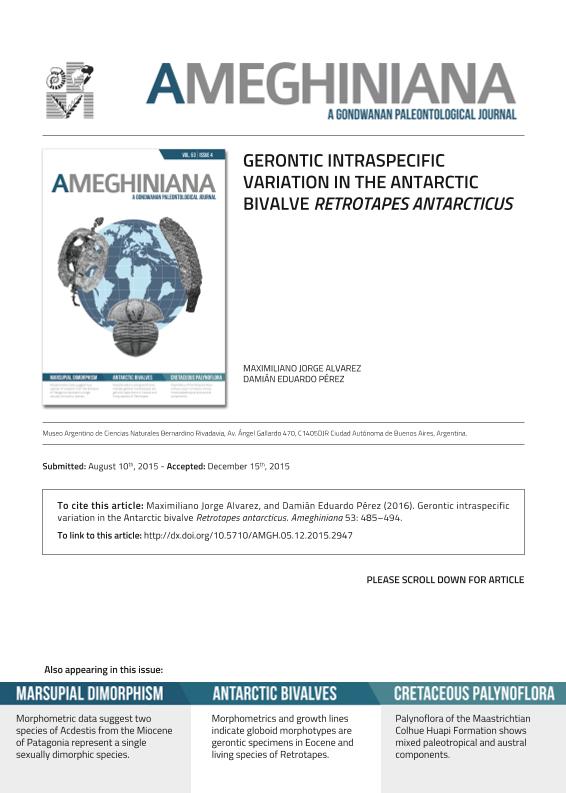Artículo
Retrotapes antarcticus, del Eoceno de Antártida, presenta dos morfotipos diferentes, uno con valvas planas y otro con valvas globosas. Autores previos propusieron que la especie actual Retrotapes exalbidus muestra los mismos morfotipos. Este trabajo evalúa el morfotipo globoso versus el plano, comparando ambas especies a través de un análisis de Contornos Elípticos de Fourier utilizando 17 valvas de R. antarcticus y 40 valvas de R. exalbidus. Luego se realizó un análisis de componentes principales y la edad de ambos morfotipos fue estimada a través del conteo de las líneas de crecimiento en la dirección del mismo. Varios autores argumentaron que las diferencias genéticas entre ambos morfotipos de R. exalbidus no permiten considerarlos como especies distintas y plantearon que tal vez los morfotipos globosos se correspondan con especímenes gerontes. Nuestros resultados demuestran que la variación registrada en R. antarcticus es igual a la observada en R. exalbidus. El análisis de las líneas de crecimiento confirma que el morfotipo globoso corresponde a especímenes gerontes en ambas especies. Esto constituye un ejemplo de variación intraespecífica geróntica. Además, esta contribución nos permite conocer más acerca del modo de vida del bivalvo fósil R. antarcticus, debido a que presentan un patrón de crecimiento similar al de la especie viviente. The bivalve Retrotapes antarcticus, from the Eocene of Antarctica, includes two different morphotypes of which one presents flat valves while the other one exhibits globoid valves. Previous authors have identified the same two morphotypes in the extant species Retrotapes exalbidus. This paper assesses the flat versus globoid morphotypes via comparing the two species by analyzing Elliptic Fourier Contours of 17 valves of R. antarcticus and 40 valves of R. exalbidus. A principal component analysis was performed and the age of both morphotypes was estimated by way of counting growth lines. Several authors have argued that genetic differences between the two forms of R. exalbidus are not sufficient to separate them into two distinct species and suspected that the globoid morphotype may correspond to gerontic specimens. Our results demonstrate that the morphological transformation detected in R. antarcticus is similar to that observed in R. exalbidus. The analysis of growth lines confirms that the globoid morphotype corresponds to gerontic specimens in both species. This constitutes an example of gerontic intraspecific variation. Additionally, this contribution allows us to further understand the life-history of the fossil bivalve R. antarcticus for it presents a growth pattern akin to that of the living species.
Gerontic intraspecific variation in the Antarctic bivalve Retrotapes antarcticus
Título:
Variación geróntica intraespecífica en el bivalvo Antártico Retrotapes antarcticus
Fecha de publicación:
15/08/2016
Editorial:
Asociación Paleontológica Argentina
Revista:
Ameghiniana
ISSN:
0002-7014
e-ISSN:
1851-8044
Idioma:
Inglés
Tipo de recurso:
Artículo publicado
Clasificación temática:
Resumen
Archivos asociados
Licencia
Identificadores
Colecciones
Articulos(MACNBR)
Articulos de MUSEO ARG.DE CS.NAT "BERNARDINO RIVADAVIA"
Articulos de MUSEO ARG.DE CS.NAT "BERNARDINO RIVADAVIA"
Citación
Alvarez, Maximiliano Jorge; Pérez Mazliah, Damián Eduardo; Gerontic intraspecific variation in the Antarctic bivalve Retrotapes antarcticus; Asociación Paleontológica Argentina; Ameghiniana; 53; 4; 15-8-2016; 485-494
Compartir
Altmétricas




